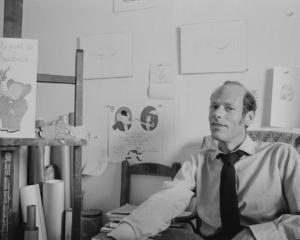Wellington writer Pip Adam is anything but subtle in her second novel, The New Animals.
THE NEW ANIMALS
Pip Adam
Victoria University Press
By JESSIE NEILSON

"It was all high gloss, high glamour out the front. But inside, not far below the surface, hardly any distance, it was ghetto.''
Kurt, Cal and Tommy are three young and up-and-coming Auckland rich kids working in the fashion industry. They do not do much besides wait for boxes to arrive from far-off shores; boxes they know will probably never turn up. They are putting together a fashion shoot for a new corporate line in menswear. For this they have young, stylish models, and these models are all getting their hair cut.
Much time is dwelt by these characters on waiting, and considering moves. The current fashion is for skulls and the embracing of ugliness. These three up-and-comers represent "the new sincere, the anti-irony''.
The main players live obsessive, inwardly-focused lives. Kurt talks to women as if to a small child he is trying to coax out of a tree. Tommy, in his own way, is popular. He has 5000 Instagram followers. "People cared, they might not notice straight away . . . but they'd notice eventually . . .''
He also loves Crossfit: "He was strong, getting stronger, always getting stronger''. And he can drive, he's a good driver, he'd been driving since he was 15, but he didn't like to drive. He does like white T-shirts, though, and if he was being honest with himself he had only started this company so he could make a magnificent white T-shirt to include in their menswear collection.
There are some older characters in their 40s, too.
Hairdresser Carla owns a female pitbull called Doug, and though she knows in her heart of hearts that it will kill her one day, she still keeps it. Sometimes she and her friends simply abuse it in order to have power over the animal. Carla is known for her bad life choices, her bad money choices, her bad choices in women and men.
Carla and Duey are old friends. Well, they are sort-of still friends but not really. It is messy and very hard to explain. Duey comes across as androgynous. Duey and Carla have not slept together, believe it or not, but Carla and Elodie have. Everybody loves Elodie.
Tommy realises that what he hates about Carla is that "she never stood up on either side, she never had an opinion on anything but at the same time she gave an impression she had opinions that were important and made her important''. The real problem with Carla, when one thinks about it, as these characters do a lot, is that she is menopausal - probably - and people expect her to be an old wench, dried up and grumpy. She's not really angry, though; that's the terrain of hairdresser Duey, who does a "great line in annoyed and angry''.
None of the characters are meant to be likeable. Sharona is another case in point, a woman tired of existing. She had the misfortune to give birth to a little girl, so she gave her up. According to her, "Having a baby was awful. She didn't like it at all. It was like the second the small girl took her first breath someone pushed Sharona off a cliff and she just flailed from then on''.
Wellington writer Pip Adam is not aiming at subtle writing in her second novel, commenting as she is on the superficiality of the fashion industry. Short, static and repetitive sentences continually puncture the page, portraying the tiresome lives of vacuous, shallow characters. Working out of an industrial building they sip peppermint tea, check their phones, and incessantly ponder their own motivations and whether they should follow actions through or just leave them for another day. However, to read about this is depressing.
There is a deeper momentum in the last third which swings towards an entirely different pace and scene. The writing is, likewise, a lot more eloquent. It acts as a break from the stasis, where they investigate how to metamorphose into "new animals''.
However, all in all, it is very hard to get past the utterly superficial characters of the first two-thirds, from which we gain very little, and the prose style which mimics the antipathy and purposelessness of the characters within their own melodrama.
Jessie Neilson is a University of Otago library assistant.











